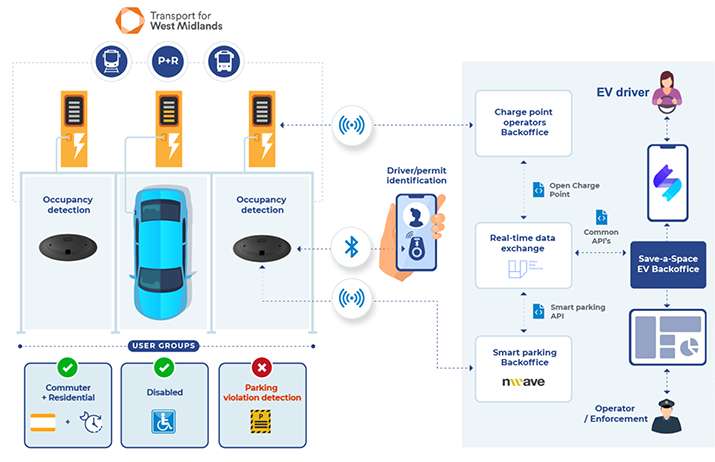Why Taking Control over Your Urban Data Streams Matters
The emergence of the Internet of Things (IoT) over the past decade is now enabling a new wave of digital transformation currently taking place in cities and communities around the world. Previous waves of digital transformation focused on improving public service delivery by digitizing time-consuming, often paper-based workflows (e-governance) or better sharing and using data generated within cities and local authorities (open data).
However, the adoption of IoT now provides actionable information and insights about the real world in much more detail than ever before, covering all aspects of urban life - the high street, the roads, the transportation network, the buildings, and the environment. This opens up new opportunities to react much better to real-world situations and optimize everything, from service delivery to policy interventions.
IoT Roll Out in Cities Is Picking Up Pace
Many cities and rural communities are therefore experimenting with different points based IoT solutions to solve specific urban challenges such as improving parking, road traffic, transportation services, adult social care, air quality, public safety, energy management for public buildings and public streetlights, and responses to flooding and pandemics. This list of IoT use cases is by no means exhaustive and, instead, growing rapidly, fuelled by public money from EU[1] or national initiatives[2] and cheaper and simpler IoT systems and network infrastructures that can deliver viable business cases for deployment.
At the same time, new forms of urban infrastructure are emerging to enable more sustainable modes of transport and mobility services. This includes public and private electric vehicle charge points to support a rapid transition to zero-emission transport, e-mobility hubs for car-sharing, e-bikes, and e-scooters. In addition, our energy production is becoming more decentralized, fuelled by renewable energy sources that are now deployed at public and private buildings and housing estates.
The Challenges of Obtaining IoT Data Access
Common to all these systems is that they generate and use an increasing amount of real-time data about the urban environments in which they are operating. These urban data streams enable operational efficiencies and service improvements or entirely new service experiences.
On paper, it seems that a rich layer of real-time urban information is slowly emerging that cities and other stakeholders operating in urban environments can tap into at will. This would enable the creation of urban digital twins for better urban planning and service operations, infrastructure planning and investment decisions, and new innovative services and applications that improve public service delivery and the quality of life of every citizen.
In reality, such urban data streams are locked away in different vendor systems, often only accessible via service dashboards, spreadsheet exports, or proprietary APIs.
As soon as a city or urban infrastructure operator wants to go beyond accessing data through the usual service dashboards, they enter uncharted territory as their system providers and operators are not used to dealing with sharing data from their systems or are reluctant to do so, as they fear being undercut in their business model. Accessing urban data streams is often a tedious process, even if cities have paid for the IoT infrastructure rollout and/or service and infrastructure maintenance.
In the best case, APIs are already available at their solution provider backend systems. However, in cases where API access is shared with additional users, suppliers typically charge the $1000s for the provision of new user accounts and access credentials for every request. Besides this, the often-proprietary nature of APIs requires the involvement of data engineers or developers to effectively integrate the API and streamline the data formats coming out of them before they can become usable.
A further complication often encountered is that data ownership is not adequately clarified at system procurement time. This causes additional delays and complications as suppliers are reluctant to renegotiate initially agreed terms. In some cases, data sharing agreements must be put in place, or existing ones tweaked. Sometimes the supplier may refuse to provide alternative access to its system data. This is precisely the case where no direct API access is available, and the service user just gets a dashboard view of their data and perhaps the ability to export a CSV dump of it. If API-based access becomes essential, it will require a lengthy process on the supplier side with additional costs to make such APIs available.
Therefore, the best moment to ensure convenient access to data from IoT and other urban real-time systems is at procurement time. However, many organizations overlook the importance of unlocking data for further use beyond the shiny service dashboards.
Creating Value from Data Requires Data Sovereignty
As we move towards a future where access to relevant data about the real world is crucial for successful urban service delivery and adequate policy and decision making, mastering data sovereignty is a keystone to be successful. Data sovereignty in this context implies that organizations have easy access to all their urban data streams whenever they need it, so they can be effectively discovered, used across different departments in their organization, and shared with colleagues, partners, consultants, or innovators that are part of an urban ecosystem. This requires adequate tools that support organizations to manage their real-time data ecosystem. One of these tools is the Urban Data Exchange[3] (UDX). This real-time data-sharing platform is a common space for consolidating live streams of urban data for more efficient discovery, management, and access. UDX enables data sovereignty by ensuring that organizations can access data they own from different systems whenever they need it. Furthermore, by providing a common hub for all urban data streams, they can request system suppliers from day one to guarantee access by directly integrating their data with UDX.
UDX also simplifies the process of running urban data-related projects. Organizations spend less time and effort on data discovery, validation and wrangling, and negotiating access to data. They also spend less effort on making urban data streams available and drawing up licenses and sharing agreements. Additionally, once data streams are integrated with UDX, they can be easily accessed following Open and Agile Smart Cities Minimum Interoperability Mechanism[4] and re-used again and again for future projects.
In the following, we briefly discuss two ongoing projects where our partners leverage UDX to achieve data sovereignty and improve public sector service delivery with improved access to their data.
Better Planning of Electric Vehicle (EV) Infrastructure Investments
Local authorities are responsible for ensuring rapid decarbonization of their transport infrastructure to enable the net-zero ambitions set out by their governments. For example, the UK government has banned the sale of fossil fuel cars by 2030[5] and phasing out all commercial vehicles by 2035[6]. This puts considerable pressure on cities and urban infrastructure operators that an adequate EV charge point infrastructure is in place to enable this transition. Forecasts predict that between 280,000-350,000[7] public charge points are needed in the UK alone, and only 27,000[8] are currently available, a more than tenfold increase over the next decade.
To ensure appropriate investment decisions in future EV infrastructure rollout that deliver value for public money and support the actual market demand, insights from existing EV infrastructure use are essential. The Greater London Authority (GLA) is building a tool for forecasting EV charging demand to enable London Boroughs to understand better current and future demand of EV charge points in their constituencies so they can be deployed in the right places at the right time.
More than a dozen charge point operators (CPOs) are active in Greater London. The GLA has agreements with many of them individually to access some of the usage data across their charge point networks. Some of this data is accessible via some proprietary APIs, but in most cases, this data is provided only monthly as an excel sheet from different CPOs. Keeping this EV demand insights tool up to date is a considerable burden that requires data wrangling with different APIs, repeated data cleansing and reformatting, and imports of different spreadsheets, which are occasionally also changing. As part of the EIT UDX project[9], we are exploring an alternative approach to simplify this process considerably and minimize potential errors and the human efforts needed. By directly connecting real-time event streams from different charge point networks into UDX via standards-compliant APIs such as OCPI, we ensure that usage data can be accessed promptly without the need for frequent manual interventions in the workflow, leading to more cost efficiencies and more reliable decision making.
Improving EV User Experience and Park and Ride Car Parks
Transport for West Midlands is a major urban infrastructure operator in the UK with a large estate of park and ride (P+R) car parks at train stations and other transport hubs.
Providing charging opportunities for EVs at P+Rs is a high priority but getting the user experience right for EV drivers is challenging. For example, such chargers might be broken or blocked by a fossil fuel vehicle or an EV that is not charging. Furthermore, charge points currently can only report availability events when a vehicle is actively connected or unplugged. In the above cases, EV users may wrongly assume parking space availability with an electric charger leading to frustration and anxiety when using their EV. Furthermore, inefficient use of such EV charging-enabled parking spaces is difficult to enforce.

Figure 1: Integrating real-time data from smart parking sensors and EV charge points to improve enforcement and user experience at EV charging bays.
In the Reserve&Charge project, we explore the potential of advanced reservation of car parks with chargers by EV users at P+R locations, as shown in Figure 1. By integrating real-time data coming from EV chargers and smart parking sensors, we can determine parking space occupancy and events of non-compliant use reliably. Furthermore, the parking sensors can detect user registration events by using a Bluetooth tag in a user permit or mobile app. This allows us to validate whether the user with an adequate booking has arrived at his reserved parking spot.
Conclusion
Data streams from IoT devices and urban infrastructures are becoming an essential part of how we operate urban infrastructure, deliver public services, and carry out urban planning and infrastructure investments. Gaining access to urban data streams from different systems is essential to ensure that cities and infrastructure operators can leverage these in an integrated fashion to forge their own future, achieve sustainability targets, and show necessary resilience.
Acknowledgments
EIT UDX project has received funding from the European Institute of Innovation and Technology (EIT). This body of the European Union receives support from the European Union's Horizon 2020 research and innovation program. Reserve&Charge is funded by the Office for Zero Emission Vehicles (OZEV) in partnership with Innovate UK.
[1] https://digital-strategy.ec.europa.eu/en/policies/large-scale-pilots-smart-cities-and-communities
[2] https://www.innovateproject.org/
[3] https://urbandata.exchange/
[4] https://mims.oascities.org/
[5] https://www.gov.uk/government/news/government-takes-historic-step-towards-net-zero-with-end-of-sale-of-new-petrol-and-diesel-cars-by-2030
[6] https://www.gov.uk/government/news/uk-confirms-pledge-for-zero-emission-hgvs-by-2040-and-unveils-new-chargepoint-design
[7] https://www.gov.uk/government/publications/electric-vehicle-charging-market-study-final-report/final-report
[8] https://www.zap-map.com/statistics/
[9] https://www.urbandatacollective.com/projects/udx
 Alex Gluhak is the founder and CEO of Urban Data Collective, a UK startup with the mission to democratize access to real-time urban streams. He is an experienced technology leader and evangelist for IoT technology and its application to Smart Cities and Communities. Alex was involved in some of the key European smart city projects such as SmartSantander, OrganiCity, and SynchroniCity and has followed the entire IoT cycle from early research to mainstream adoption.
Alex Gluhak is the founder and CEO of Urban Data Collective, a UK startup with the mission to democratize access to real-time urban streams. He is an experienced technology leader and evangelist for IoT technology and its application to Smart Cities and Communities. Alex was involved in some of the key European smart city projects such as SmartSantander, OrganiCity, and SynchroniCity and has followed the entire IoT cycle from early research to mainstream adoption.
 Sarah Gallacher is a co-founder and the Engineering Lead at Urban Data Collective and has previously held roles at Intel, Arup, and the Digital Catapult. She has over 15 years of experience in Computer Science and IoT systems, focusing on software, applications, and cloud computing. Sarah has delivered award-winning IoT concepts across domains, including the Built Environment, Smart Cities, and Ecology, and her work is widely published internationally.
Sarah Gallacher is a co-founder and the Engineering Lead at Urban Data Collective and has previously held roles at Intel, Arup, and the Digital Catapult. She has over 15 years of experience in Computer Science and IoT systems, focusing on software, applications, and cloud computing. Sarah has delivered award-winning IoT concepts across domains, including the Built Environment, Smart Cities, and Ecology, and her work is widely published internationally.
Sign Up for IoT Technical Community Updates
Calendar of Events
IEEE 8th World Forum on Internet of Things (WF-IoT) 2022
26 October-11 November 2022
Call for Papers
IEEE Internet of Things Journal
Special issue on Towards Intelligence for Space-Air-Ground Integrated Internet of Things
Submission Deadline: 1 November 2022
Special issue on Smart Blockchain for IoT Trust, Security and Privacy
Submission Deadline: 15 November 2022
Past Issues
September 2022
July 2022
March 2022
January 2022
November 2021
September 2021
July 2021
May 2021
March 2021
January 2021
November 2020
July 2020
May 2020
March 2020
January 2020
November 2019
September 2019
July 2019
May 2019
March 2019
January 2019
November 2018
September 2018
July 2018
May 2018
March 2018
January 2018
November 2017
September 2017
July 2017
May 2017
March 2017
January 2017
November 2016
September 2016
July 2016
May 2016
March 2016
January 2016
November 2015
September 2015
July 2015
May 2015
March 2015
January 2015
November 2014
September 2014


